Error 5 Access Denied on Windows
Error 5: Access denied is a known issue on Windows 10. This error prevents you from installing software on your computer and accessing or modifying certain files.
What Causes the ‘Error 5: Access Denied’ Issue?
The reason for this issue is the unavailability of permissions. Windows 10 will prevent you from installing if you don’t have Administrator privileges or if your account is not the Administrator account.
Getting administrator privileges for your account on the computer solves this problem. But before moving on, temporarily disable your Anti-virus program and see if this makes any difference. If it does, it probably means that the Antivirus was the culprit. If not, you can continue with the solutions below and enable the Antivirus later on.
How Can I Fix Error 5: Access Denied?
Method 1: Fixing Security Permissions of the Temp folder
- Press Windows Key once and click File Explorer.
- Type
 in the address bar located in the middle top of File Explorer and press Enter.
in the address bar located in the middle top of File Explorer and press Enter. - Locate the Temp Folder and right-click on it then select Properties.
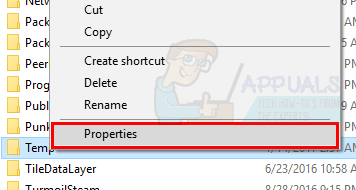
Open Properties of Temp Folder - Click the Security tab and then click Advanced.
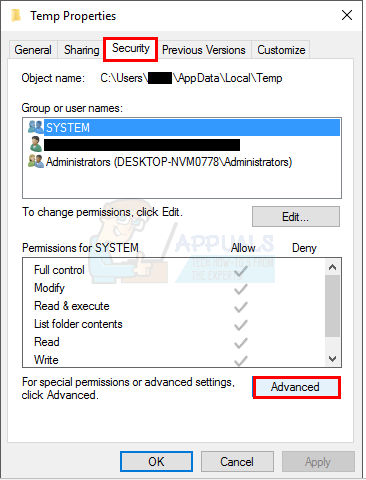
Click Advanced in Security Tab - Check if Replace all child object permissions with inheritable permissions from this object is ticked. If it isn’t, then check it and click continue.
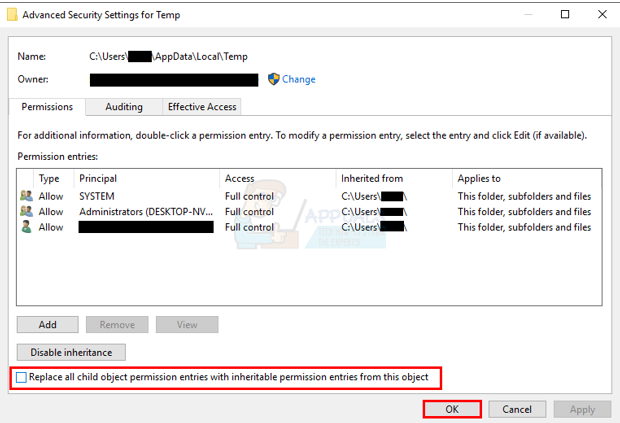
Check the Option of “Replace all child object permissions with inheritable permissions from this object” - Now select any entry that isn’t inherited from C:\Users\[Username]\ folder and click Remove.
- Click Apply then click OK.
Method 2: Get Administrator privileges
Make sure you have the Administrator privileges before trying to run the setup. To do that, right-click on the setup that you are getting the issue on and select Run as Administrator.
Method 3: Make your profile Administrator
- Hold Windows Key and press R.
- Type netplwiz and press Enter.
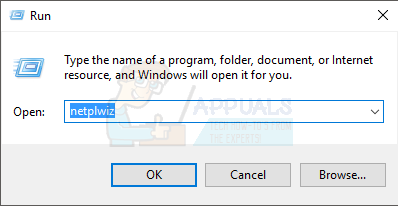
Run netplwiz Command - Select the user that you want to make the administrator of the PC.
- Click Properties.

Change Properties of the User - Click Group Membership tab.
- Click the Administrator and click Apply. Then click OK.

Method 4: Moving the installer
If you are getting the error on a specific installer then copy or move it to Drive C or whatever drive Windows is installed on and then try to run it. It should fix the issue.
Method 5: Enable Built-in Administrator account
Basically, when you install Windows 10 then Windows create 2 extra accounts for you on its own. One of them is a guest account and the other one is an administrator account. Both of these are inactive by default.
You can check the account by performing the following steps
- Hold Windows Key and press X (release Windows Key). Click Command Prompt (Admin).
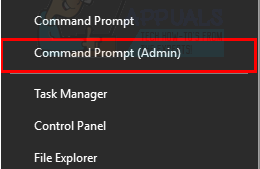
Open Command Prompt (Admin) - Type net user and press Enter.
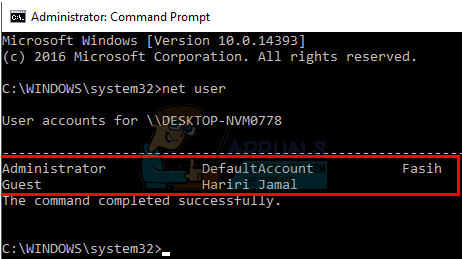
The main difference between your administrator account and the built-in administrator account is that the built-in administrator account has full unrestricted access to your computer. So, enabling the built-in administrator account can be helpful when you are having privileges problem on Windows 10.
These are the steps for enabling the built-in administrator account.
- Hold Windows Key and press X (release Windows Key). Click Command Prompt (Admin).

Open Command Prompt (Admin) - Type net user administrator /active:yes and press Enter. You should see a message Command run successfully.
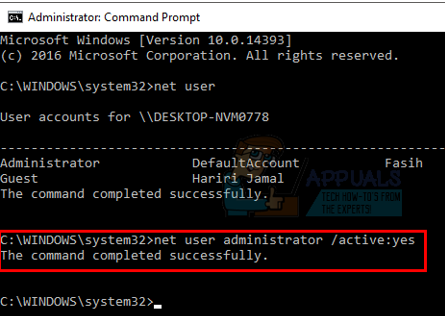
Run net user administrator /active:yes in Command Prompt
It’s always good to password protect your administrator accounts to prevent people from making changes in the PC.
- Type net user administrator <Password> and press Enter (you should write the password which you want to set for the administrator account in place of <Password>).
OR
- Type net user administrator * and press Enter. You will be asked twice to enter the password that you want to set for the administrator account. Just type your password and press Enter.

Now try to run the program and there shouldn’t be a problem. If you want to disable the administrator account then follow the below step.
- Hold Windows Key and press X (release Windows Key). Click Command Prompt (Admin).
- Type net user administrator /active:no and press Enter.

Method 6: Adjust UAC Settings
This step is not recommended as it will make your system vulnerable to many threats. There are some applications that are not compatible or conflict with the UAC (User Account Control) settings. Disabling the UAC (to minimize the UAC’s interference in application installation and folder access) may solve the problem. UAC is the main security firewall which prompts for a password or authentication when you are installing or running software.
- Press the Windows key, type UserAccountControlSettings and in the results, click on UserAccountControlSettings.
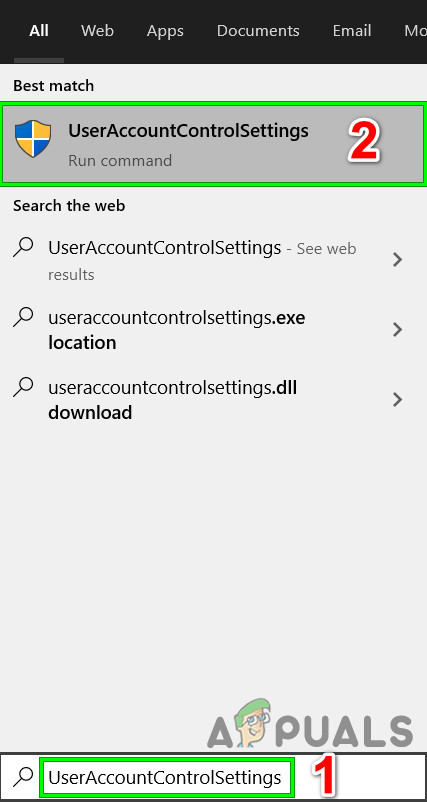
Open UserAccountControlSettings - Now in the User Account Control Settings window, adjust the slider to Never Notify and then click OK.
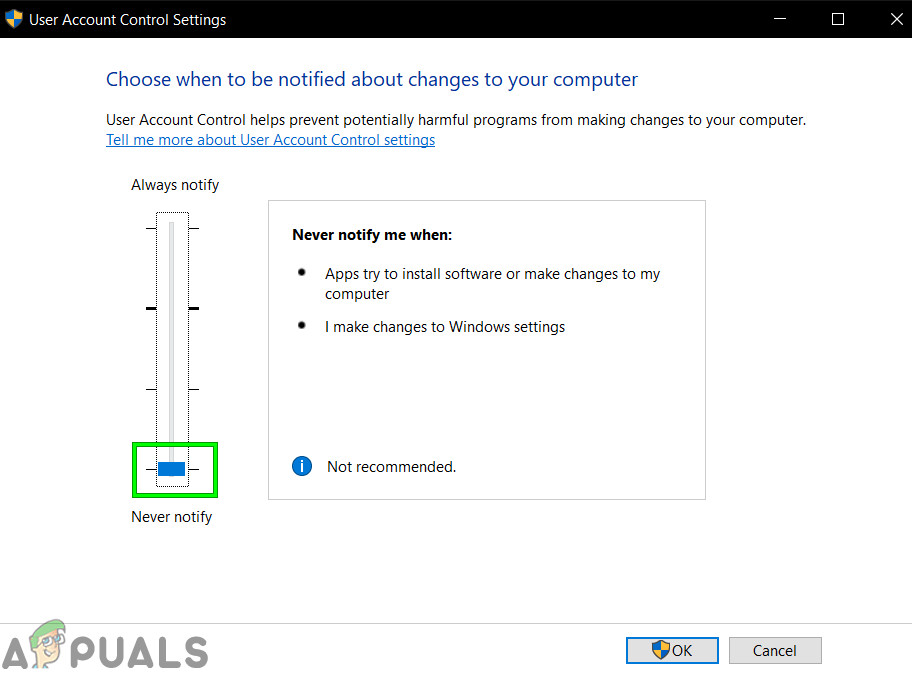
Adjust the slider to Never Notify - Now install the application or perform the action you were trying to complete.